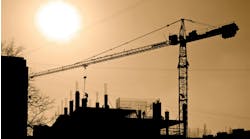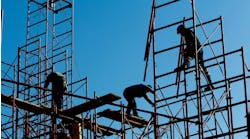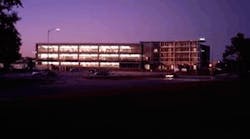HOUSTON — NASA’s Johnson Space Center (JSC) now has three U.S. Green Building Council (USGBC) Leadership in Energy and Environmental Design (LEED) certified buildings on its campus — recently the expansion of Building 265, the Source Board Building addition, received LEED Gold certification, making it the third LEED building on campus — and Building 20 is registered for LEED Platinum certification, plus, more sustainable buildings are in the works.
At this time, there are four other LEED registered buildings in the construction or design phase at JSC. The Human Resources and Financial Management building is registered to receive LEED Platinum certification; The Public Affairs building and The Center for Space Flight Performance and Research building are registered for LEED Gold; and the CEV Avionics Integration Laboratory is registered for LEED Silver.
Building 20, an 83,000-sq.ft. three story office building, built to support NASA’s building refurbishment program, providing “flex” space for employees that need to relocate their offices due to a building’s refurbishment, utilizes many sustainable systems and products to cut energy and water consumption while decreasing energy and operation expenses. The building was first registered as a LEED Gold building with the USGBC, but was upgraded to Platinum and could soon receive certification.
Among the sustainable technologies and products used in Building 20 are dual-flush flushometers for water closets; 0.5 GPM electronic faucets, operating in 10 seconds durations; a solar-assisted domestic hot water system, reducing electrical power consumption; roof coating, reflecting the sun heat and energy; CO2 monitors; high-efficiency filters; and an air handler condensate collection system to provide water for irrigation of the turf areas.
“Carbon dioxide monitoring is an integral part of a demand controlled outdoor ventilation system,” explained Gary Kuzma, director of MEP Engineering, HOK, Houston, the project’s design and mechanical system design firm. “Each high-occupancy room is equipped with a carbon dioxide monitor to regulate the amount of outdoor ventilation supplied to the room to provide optimum occupant comfort using the least amount of energy. During times that rooms are unoccupied, they operate at minimum levels of outdoor ventilation. As room occupancy increases, carbon dioxide in the room increases and outdoor air ventilation increases correspondingly.”
The landscaping around the building does not need to be irrigated often since plants include native and adapted species, which reduce both maintenance and water use. Plus, no potable water is used for watering. Instead condensate is captured in the HVAC system and stored for watering the landscaping when needed.
“Air is cooled by air-handling unit cooling coils to the point of 100% relative humidity,” explained Kuzma. “As saturated air is cooled further, it changes from a vapor to a liquid (water). Cooling coil condensate is collected inside of air-handling units by sloped drain pans and connected to drain pipes. Air-handling unit drain pans are piped to a central condensate collection tank where the water is stored and used for irrigation.”
Waterless urinals are another sustainable feature of the building.
“The City of Houston allows the use of waterless urinals when a water line is installed within the chase and plumbed to suit a future urinal in the event the owner wishes to change the unit to a water flushing urinal,” explained Gary Marsh, plumbing department manager, HOK.
Besides utilizing sustainable products and systems in the facility, Building 20 was designed with a “less is more” philosophy.
“The concept behind “less is more” is based on the elimination of applied materials,” explained Frank Hersom, project manager, HOK. “For instance, in the non-carpeted areas, the floor finish was polished concrete as opposed to an applied material. So in Building 20, there are only two materials for floor finishes: carpet and polished concrete. The only exception is the break areas which were built on raised floor and have rubber flooring in lieu of carpet.”
Sustainable building policy
Approximately eight years ago, NASA headquarters, Washington, D.C., formed a team to create sustainable policies for the agency.
“We looked at many things,” explained Steve Campbell, deputy director of center operations at NASA/Johnson Space Center and member of the Sustainability Team. “NASA became a member of USGBC, and the team created a policy that new construction would be at least LEED Silver and go above that if it makes sense. This came out in 2004.”
According to Campbell, any NASA building that is built or renovated will be designed and constructed with LEED principles and receive LEED certification.
The first LEED facility built at JSC according to the sustainable building policy was the Astronaut Quarantine facility, which received certification in Feb. 2006.
“Even though some architects and contractors didn’t have much experience [building to meet LEED requirements], we pushed it [building projects] through,” explained Campbell when asked about the history of green building at NASA. “The market is tremendous now. We put [sustainable] requirements in when we put out requests for proposals, stating you need to have experience with LEED facilities and that you already worked on a LEED facility.
“We not only look at what’s good for the environment, we have to show the payback too, and show payback for building green,” added Campbell. “We do life-cycle cost analysis to figure out what is most economical; we have to do this to get approval for projects. We need to be smart and show payback on investment.”
The most recent LEED certified building on the JSC campus is Building 265, the Source Board Building addition. The 5,500-sq.ft. single story metal building for two source boards recently received LEED Gold status. Part of the Source Board Building was demolished since it was unhealthy, however, the good part of the building was saved, and an upgrade to this was done, plus, an addition to the existing building, according to Campbell.
“We also put in a high energy-efficient HVAC system for cooling and ventilation, and a CO2 monitoring system for occupant comfort,” said Campbell. “This being the Source Board Building, there weren’t a lot of windows, because of privacy, but we were able to build a higher bay where we could get some daylighting by using windows up high.”
Low-flow plumbing fixtures and sinks with the automatic sensors were installed in the building, and native landscaping around the building decreases water use also.
The next LEED building to be constructed on the JSC campus is the Human Resources and Financial Management building, which will be registered to receive LEED Platinum certification. Other sustainable projects included upgrading the central plant’s boilers by using ultra-low nitrous oxides retrofits to decrease pollution and upgrading the chillers.NASA is also working on several water conservation projects.



